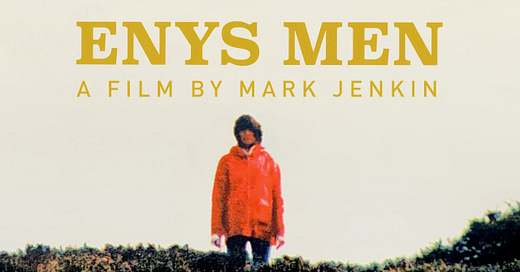Directed by Mark Jenkin
United Kingdom, 2022
So this week we are stuck on an island, an island off the Cornish coast, an island where strange things are happening. Billed as a classic of the ‘folk horror’ genre, ReidsonFilm were left wondering if this is really an appropriate label for Mark Jenkin’s latest film, Enys Men. Whether there are moments of true horror in the film is questionable, but what we are presented with is a stream of arresting, often unsettling images that left some with a sense of unease … others with a sense of boredom. The question we grappled with, however, was whether Jenkin’s film contained within it a coherent narrative or indeed did any of it make sense? And importantly, is that even a necessity?
We are in effect marooned on the island with a woman who we find from the credits is ‘the Volunteer’ (Mary Woodvine). She lives alone in a cottage, leading a spartan existence. Her role it seems is to make daily observations and record them. Her daily routine is ritualistic, walking around the craggy landscape in isolation. She throws a rock down an old mineshaft in the morning and later in the day measures the temperature besides a clump of the most artificial looking flowers seen on screen since the Little Shop of Horrors. In the evening she curls up with a book titled, ‘Blueprint for Survival’. She does have a battered VHF radio over which we hear fragmented conversations – otherwise dialogue is sparse. She drinks tea made with powdered, ‘Seven Maids Dried Skimmed Milk’, an eerie foreshadowing.
Time passes and questions mount … what is her role? How long has she been here? Answers came there none.
The Volunteer writes in her diary, everyday the same: “No change”. Looking at the dates, May Day is approaching and perhaps that is significant. Visions emerge: a group of long-dead tin miners, dancing children, a priest chanting a hymn. Most strikingly we see a group of women who look like they may be nuns, but no, they are bal maidens – 19th century Cornish women who worked in the mines, dressing the stones. A girl comes and goes – we think she is a younger version of the Volunteer. It seems that time is fracturing. And then as we reach May Day the flowers become covered with a lichen that soon begins to sprout on the body of the Volunteer…
Radio fragment: The abandoned island of Enys Men has become a monument of grief
Enys Men was shot on the 16mm film with a vintage clockwork camera. The images have a grainy look that has become Mark Jenkin’s calling card. For those readers who grew up in the UK at the time (which excludes three of ReidsonFilm) it has the 1970s aesthetic of one of those old public information films that could be as terrifying as anything on the big screen:
His cinematography is impressive: the colours are vivid, the Volunteer’s piercing blue eyes make an arresting contrast with her bright red coat – bringing to mind Nicolas Roeg’s 1970s classic, Don’t Look Now. Jenkins is also responsible for the film’s ambient soundscape: a hypnotic but unnerving score interrupted by bursts of radio static. Like Shane Carruth with Upstream Color he is ploughing a singular auteurist furrow.
Once I dropped my default viewing mode I was able to enjoy the film a lot more … its weathered 16mm cinematography style and nightmarish-folk horror elements combine to give it a uniquely eerie quality - N
The images we see arise from the land and the history of Cornwall – from the moors, the sea, standing stones, and mines. The miners, the men who made their living on the sea, and of course the bal maidens. The film did not just emerge from these images, however. The film is these images. To describe Enys Men is not to describe a story, or a plot, because story and plot demand linear time, and conventional causality. Enys Men creates a world structured very differently. Despite no obvious jump scares – although there is one crash-zoom shot that actually feels out of place here – that sense of disquiet was pervasive. A sense that was reinforced by the behaviour of the Volunteer who appeared unperturbed by these bizarre events.
But our opening question remains, when past and present are blurred, when the living and the dead merge and nothing seems to make sense, who has the confused vision? You or the filmmaker?
Standard ‘folk horror’ tropes: weirdo nuns - check, standing stone (borrowed from Into the Earth) - check, odd preacher singing plaintive hymn - check… - S
Like if you can’t just sit and enjoy a twisted psycho-spiritual journey through the time-worn Cornish landscape then I don’t know what to tell you honestly - C
Reids’ Results (out of 100)
C - 77
T - 66
N - 75
S - 59
Thank you for reading Reids on Film. If you enjoyed our review please share with a friend and do leave a comment.
Coming next … Dersu Uzala (1975)








Dear Reids on Film
There are many films you review I haven't seen, but, Enys Men, I have....
I note you show the one good image from the film, a fleeting few seconds during the longest 91mins of the 'nuns' on a cliff edge.
Enys Men is a film made to impress film critic friends and film students with in-jokes and indulgence.
Such a huge disappointment following on from the 'proper ansom' BAIT.
PS - I did enjoy the safety advert link . Truly terrifying!
I hope we both enjoy Jenkin’s next film.
Best